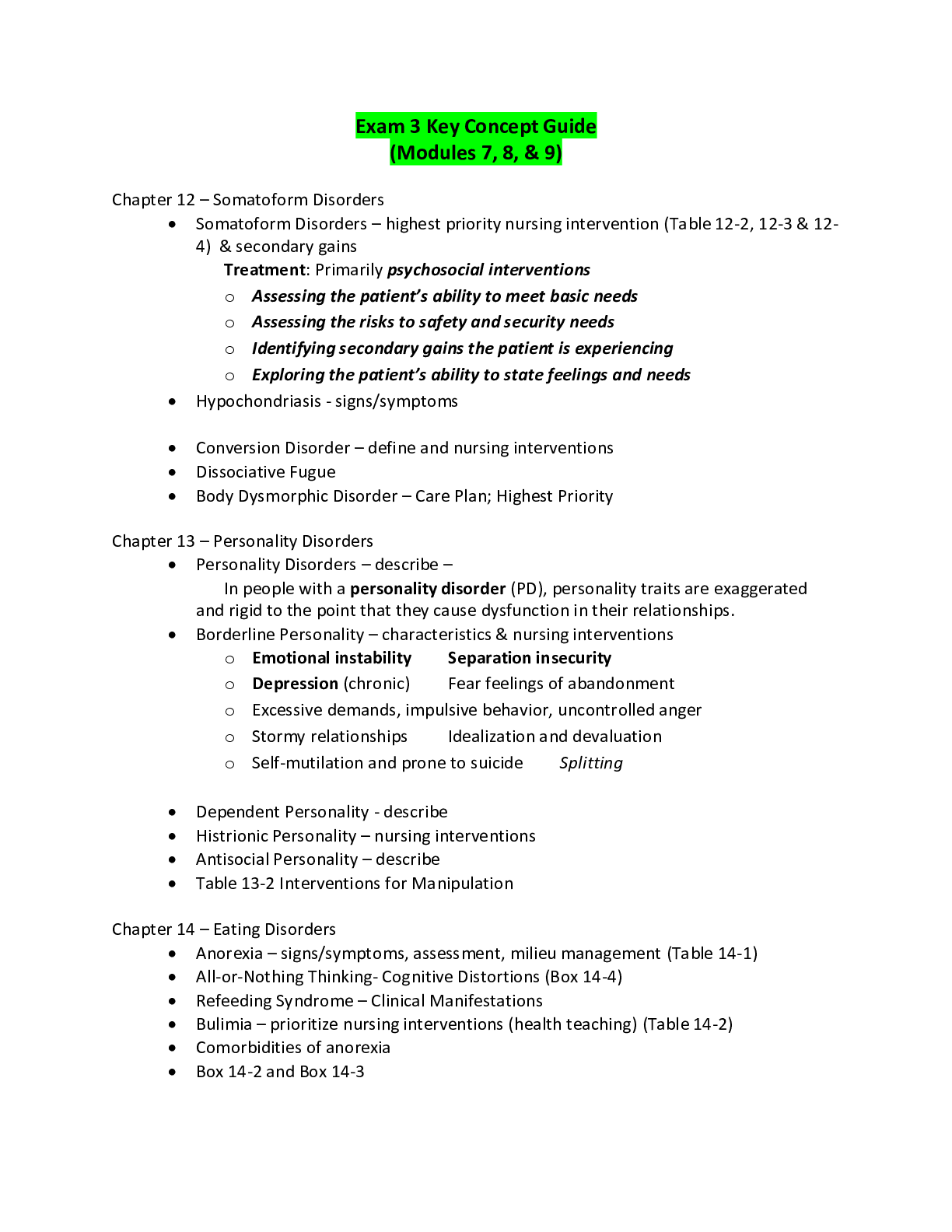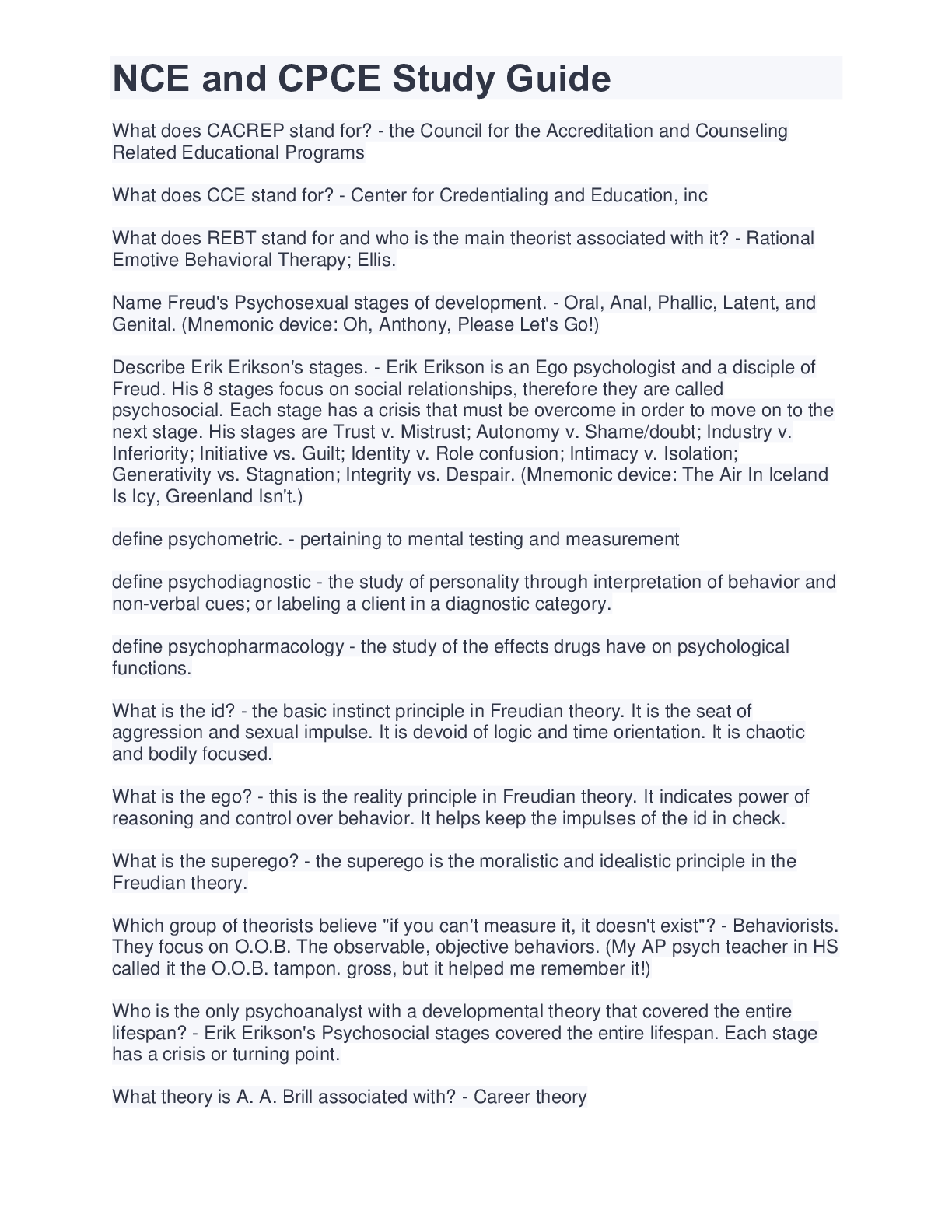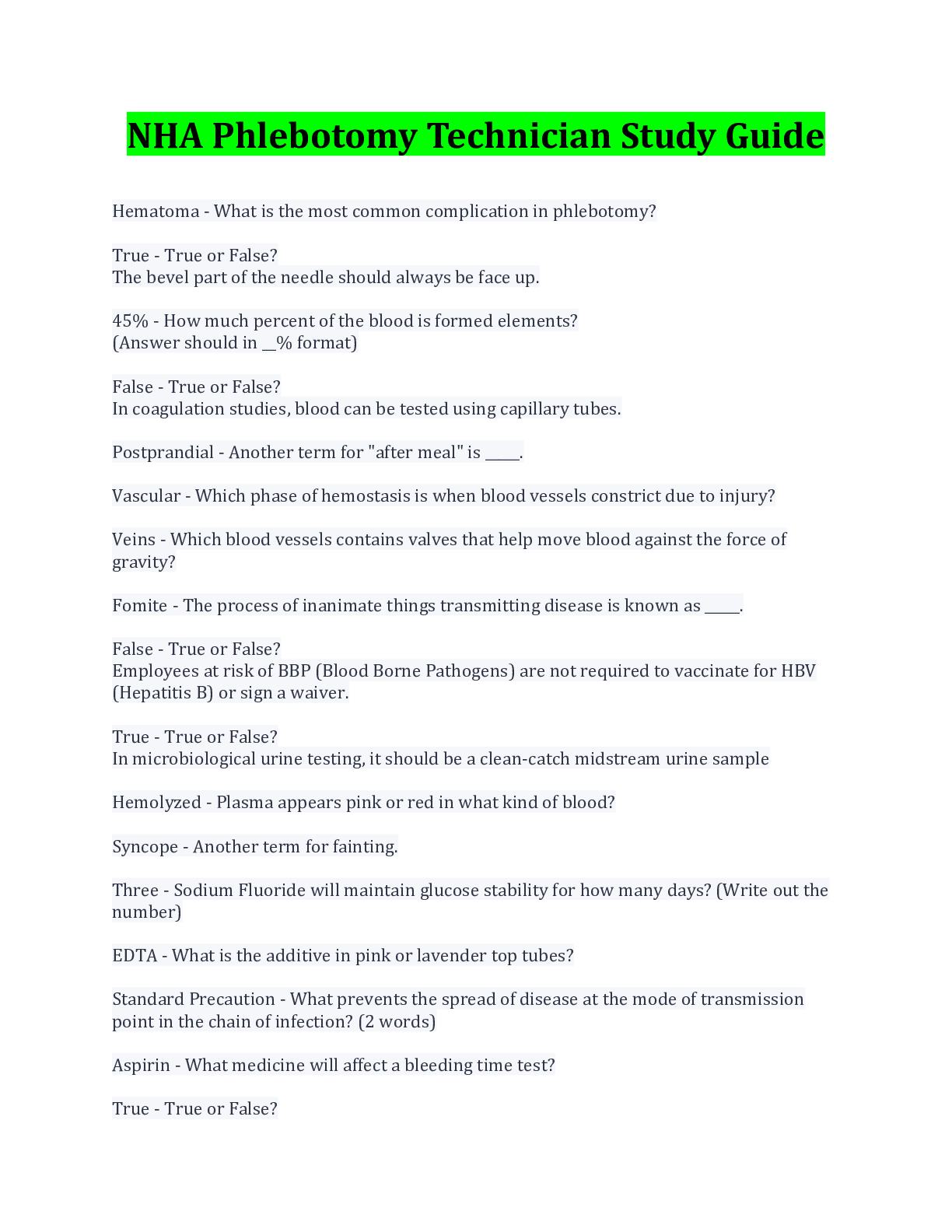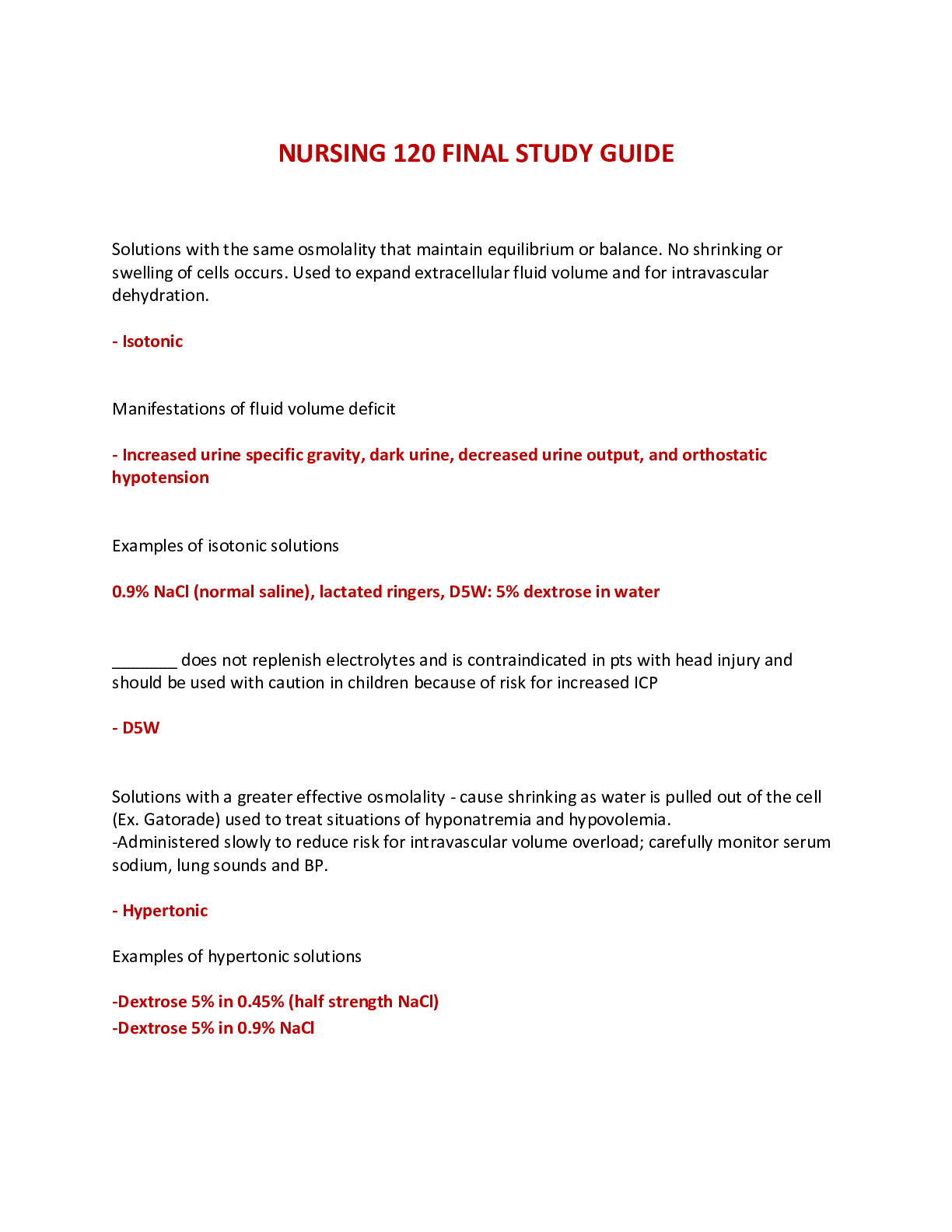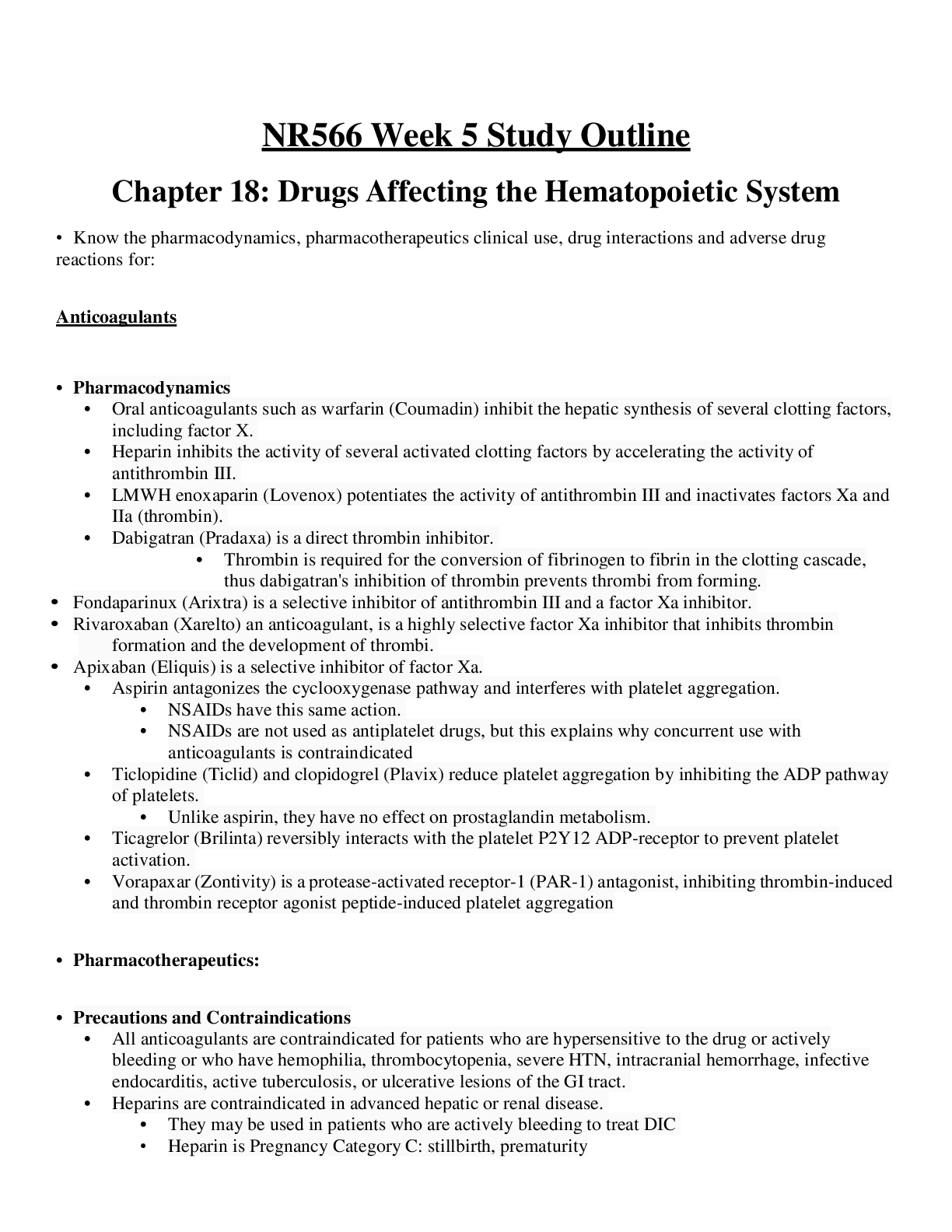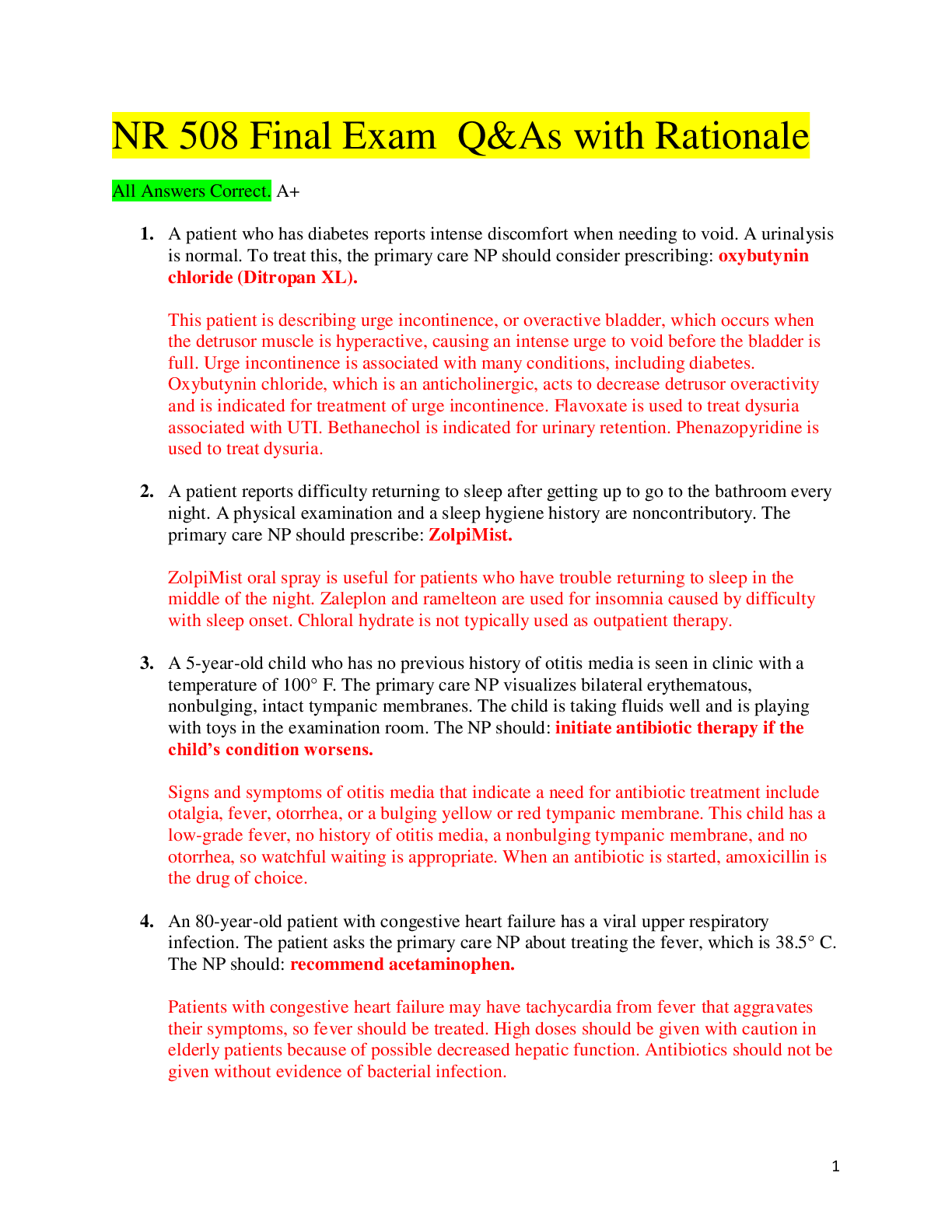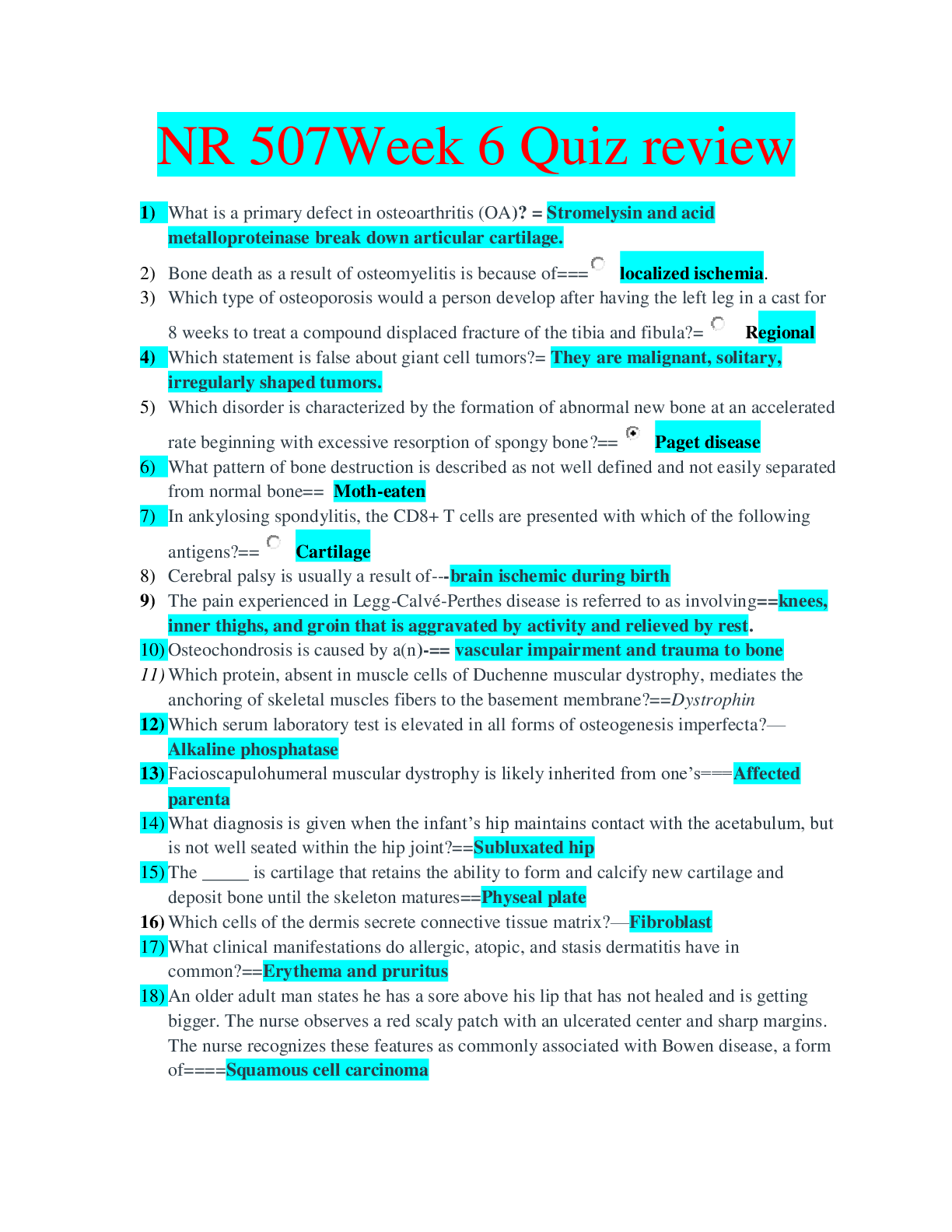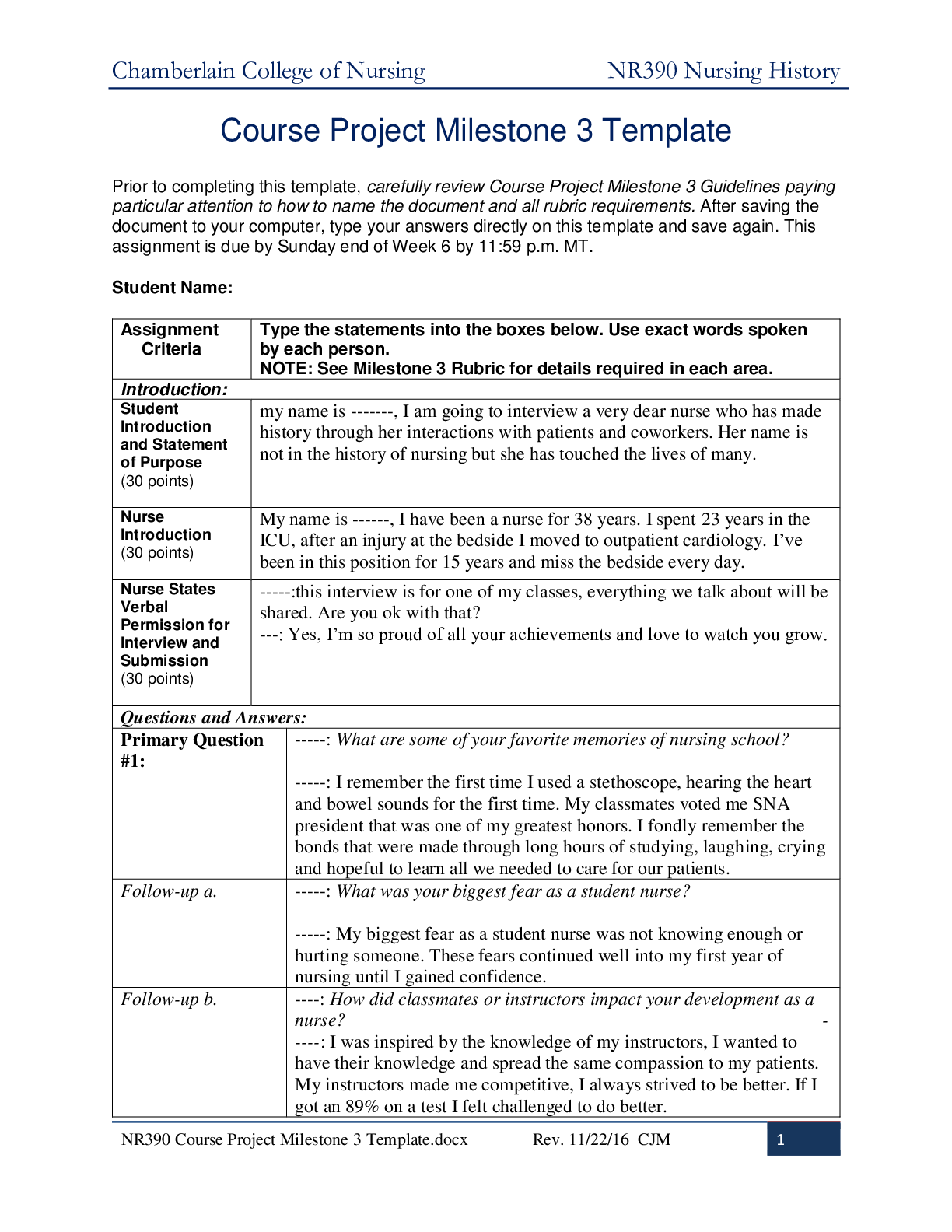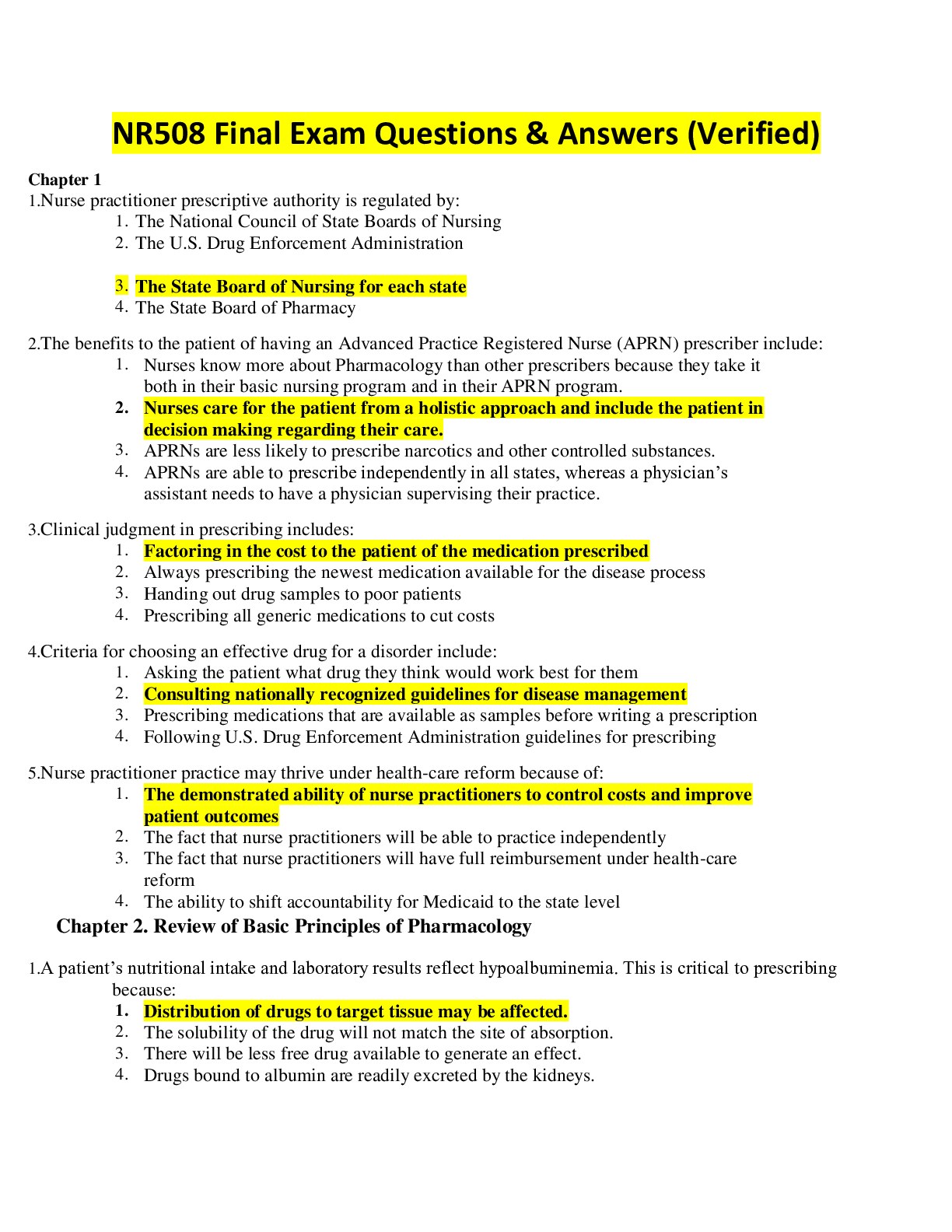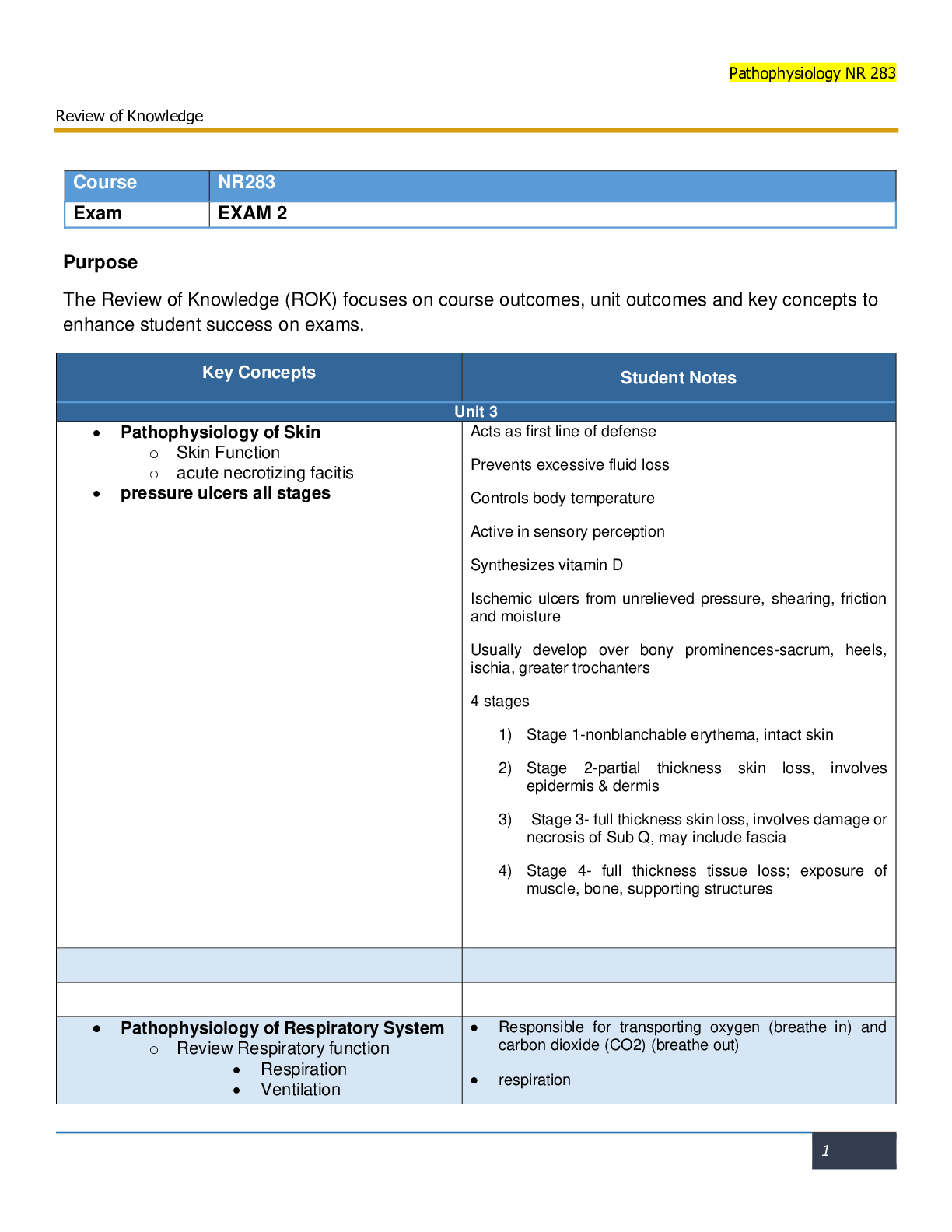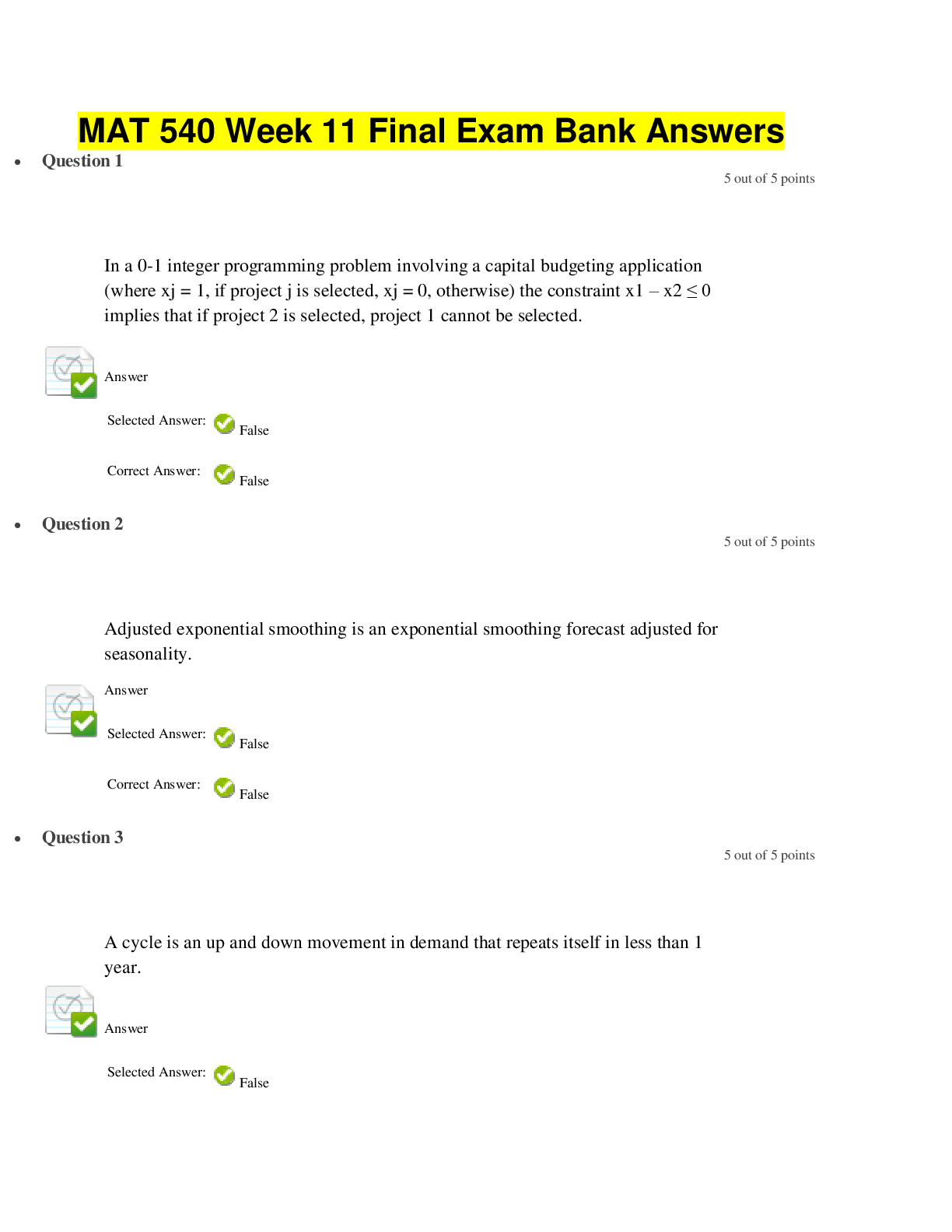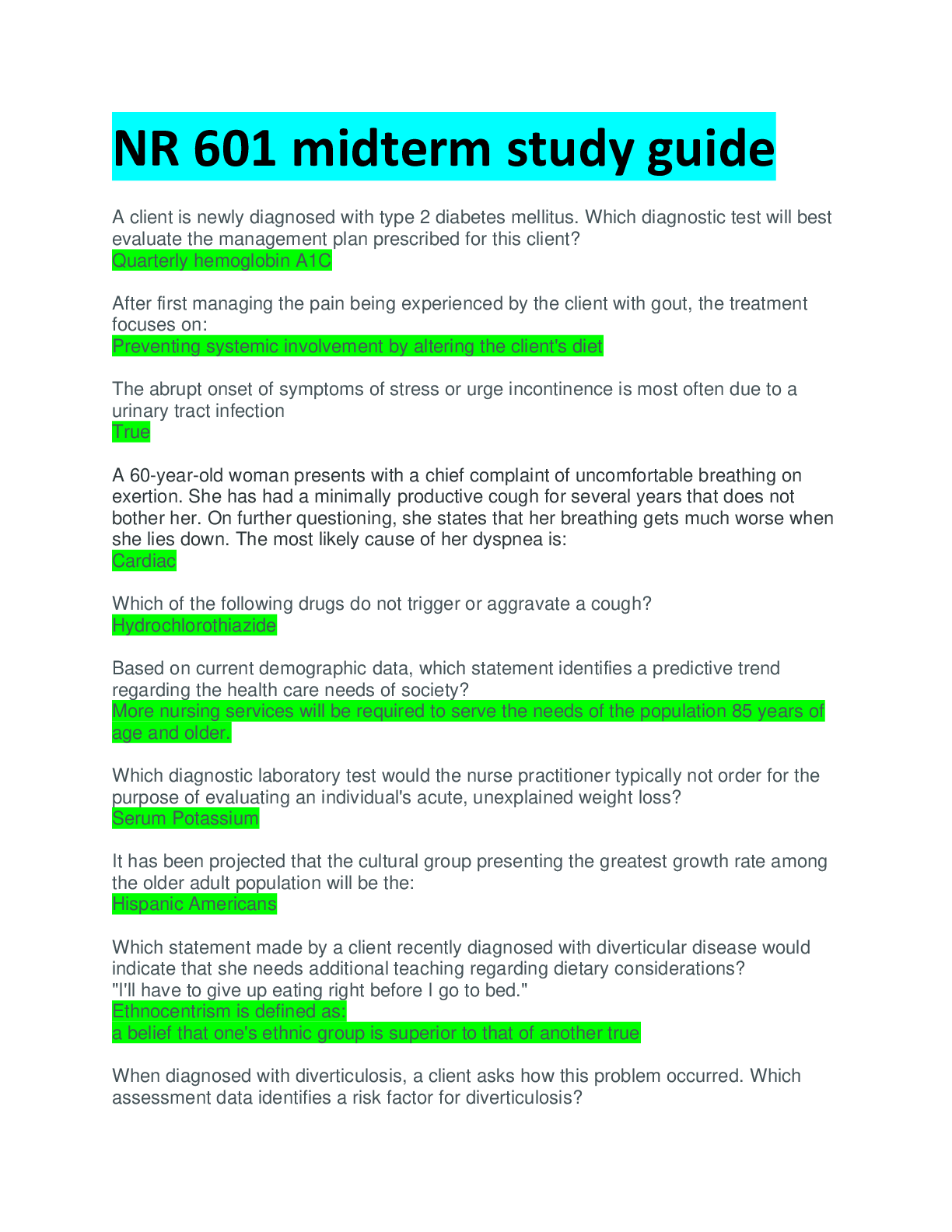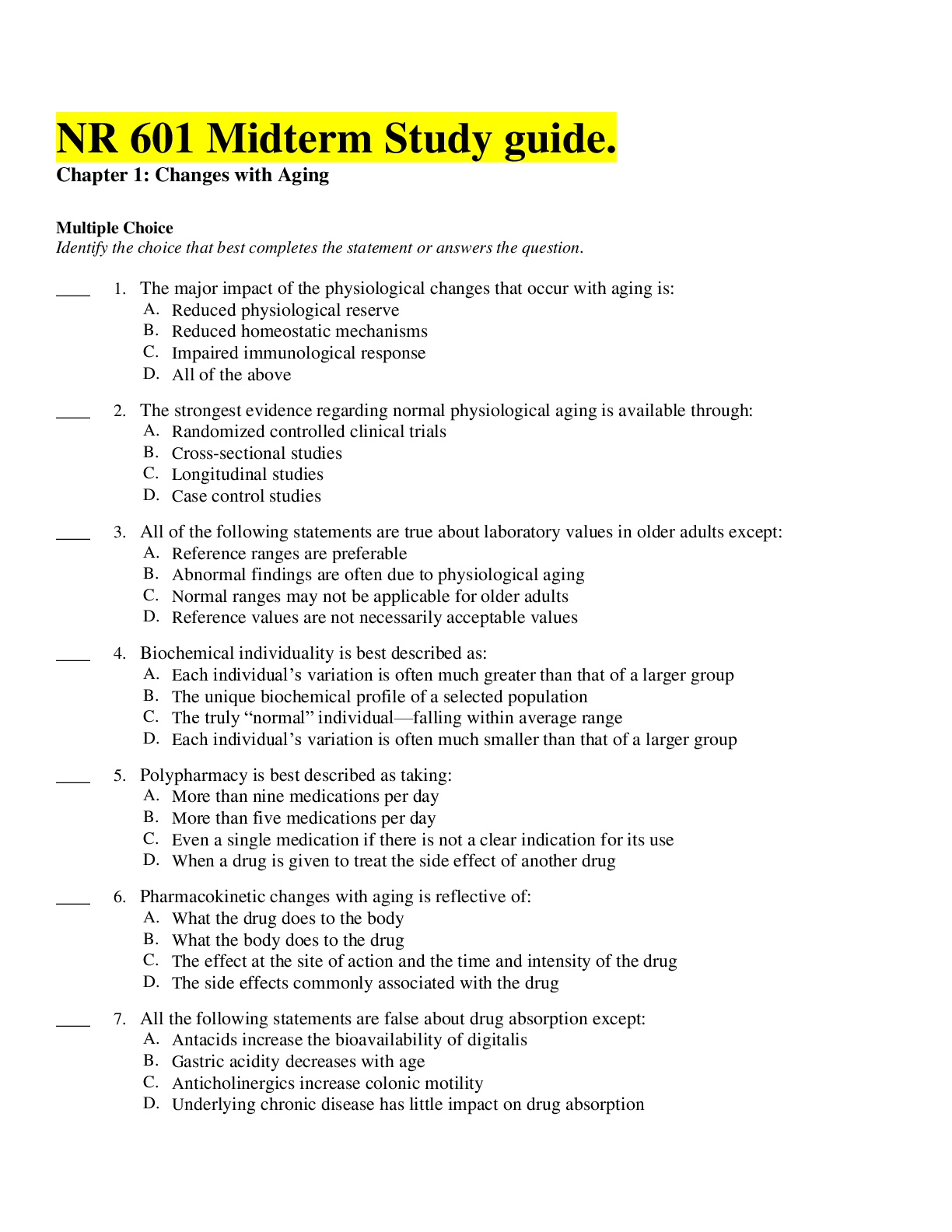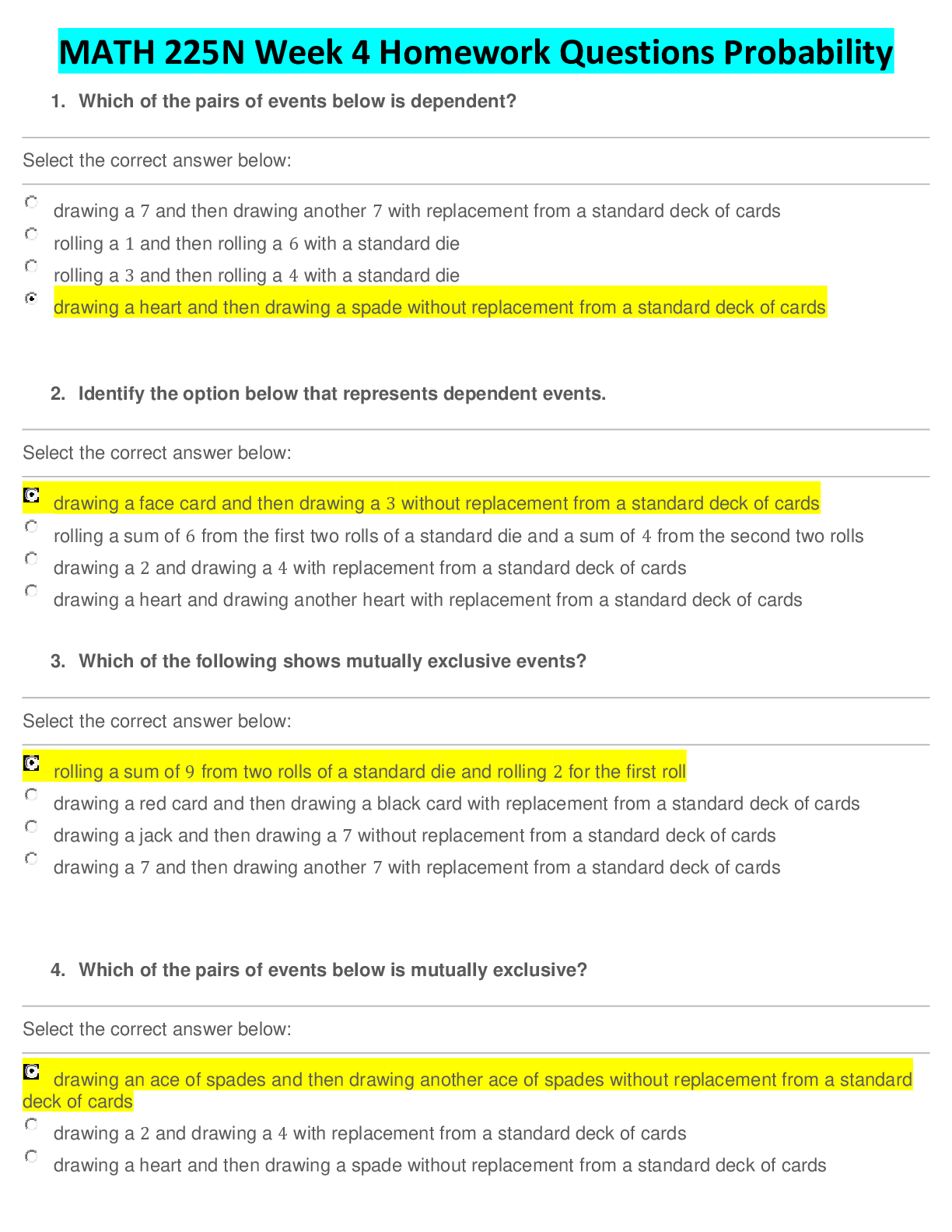*NURSING > STUDY GUIDE > CHAMBERLAIN COLLEGE OF NURSING - NURSING DIABETES M - WEEK 6 STUDY GUIDE LATEST QUESTIONS & ANSWERS (All)
CHAMBERLAIN COLLEGE OF NURSING - NURSING DIABETES M - WEEK 6 STUDY GUIDE LATEST QUESTIONS & ANSWERS
Document Content and Description Below
Week 6 Study Guide Week 6 Davis Edge Questions 1. What is the medication of choice for an initial acute attack of gout? 2. Marsha, age 24, is preparing for radioactive iodine therapy for her... Graves disease. Which test must she undergo first? 3. When teaching Marcy how to use her new insulin pump, you tell her that she needs to monitor her blood glucose level: 4. Joan has severe asthma and has been on high dose oral corticosteroids for 2 years. She has been reading some home remedy books and stops all of her medications. What condition may she develop? 5. The process of aging results in: 6. Sigrid, age 48, appears with a 3-month history of heat intolerance, increased sweating, palpitations, tachycardia, nervousness, irritability, fatigue, and muscle weakness. Which test would you order first? 7. A client with newly diagnosed diabetes who has a glycated hemoglobin (HbA1c) of 7.5 is started on therapeutic lifestyle changes (TLCs) and medical nutrition therapy (MNT). Which oral antidiabetic agent is recommended as monotherapy? 8. Mr. Reynolds is on the antithyroid drug (ATD) methimazole (Tapazole), so you make it a point to check his: 9. Steve, age 42, has never been hypertensive but appears today in the office with a blood pressure of 162/100 mm Hg. He also complains of “attacks” of headaches, perspiration, and palpitations, with frequent bouts of nausea, pain, weakness, dyspnea, and visual disturbances. He ahs lost 10lb over the past 2 months and seems very anxious today. Your next action would be to: 10. Marie, age 50, has type 1 diabetes and checks her blood glucose level several times every day. Her blood glucose levels range from 250 to 280 mg/dL in the morning and is usually about 140 at lunch, about 120 at dinner, and about 100 at bedtime. In the morning, she takes 20 units of neutral protamine Hagedorn (NPH) insulin and 4 units of regular insulin, and before dinner she takes 18 units of NPH insulin and 4 units of regular insulin. Although she has had her insulin dose adjusted several times in the past month m it has had no effect on her high morning blood glucose level. What is your next course of action? 11. After an oral cholecystogram, Sam complains of burning on urination. This is because of: 12. Which class of antihypertensive agents may be problematic for clients with diabetes? 13. The major risk factor for thyroid cancer is: 14. Marty has pheochromocytoma. You instruct him to: 15. Jeffery, age 17, has gynecomastia. You should also assess him for: 16. Jeremiah, age 72, has gout and is obese. When teaching him about diet, whick of the following do you tell him? 17. Jenny, age 46, has hypertension that has been controlled with hydrochlorothiazide 50 mg every day for the past 3 years. She is 5 ft 8 in tall and weighs 220 lb. Her fasting blood sugar (FBS) is 300mg/dL, serum cholesterol level is 250 mg/dL, serum potassium level is 3.4mEq, and she has 4+ glucosuria. Your next course of action would be to: 18. An elderly client presents with atrial fibrillation. Which of the following lab tests is important in forming the diagnosis? 19. Juanita, age 23, complains of palpitations that started a few weeks ago; the occur 2 to 4 times a day and last 5 to 10 minutes. She feels nervous and is having trouble sleeping. Her stools have been frequent (1-3 per day) and loose. She is taking levothyroxine 150 mcg daily. Her labs indicated free thyroxine (T4) 2.28 and thyroid-stimulating hormone (TSH) 0.022. She has a history of Graves disease and had radioactive iodine (RAI) treatment a few months ago. She has been on thyroid replacement for 2 months. Based on these data, you decide to: 20. Ben, a client with type 1 diabetes, is hospitalized with an admitting diagnosis of diabetic ketoacidosis (DKA). Which of the following signs and symptoms would be consistent with this condition? 21. A low thyroid-stimulating hormone (TSH) can lead to: 22. Sara, age 40, has diabetes and is now experiencing anhidrosis on the hands and feet, increased sweating on the face and truck, dysphagia, anorexia, and heartburn. Which complication of diabetes do you suspect? 23. Martin, age 62, has acute nontransient abdominal pain that grows steadily worse in the epigastric area and radiates straight through to the back. The pain has lasted for days. He is also complaining of nausea, vomiting, sweating, weakness, and pallor. Physical examination reveals abdominal tenderness and distention and a low-grade fever. What do you suspect? 24. Your client with diabetes asks you about insulin glargine (Lantus). You tellher that: 25. Harriet, age 62, has type 1 diabetes that is well controlled by insulin. Recently, she has been having marital difficulties that have left her emotionally upset. As a result of this stress, it is possible that she will: 26. Jennifer has diabetes mellitus (DM) and is injecting 30 units of Novolin 70/30 with breakfast and 18 units at bedtime. She is complaining that she woke up once in the middle of the night with palpitations and sweating. Based on this information, what do you recommend? 27. Leah, age 70, has had diabetes for many years. When teaching her about foot care, you want to stress: 28. Mason, age 52, has diabetes mellitus (DM) and is overweight. You now find that he is hypertensive. How should you treat his hypertension? 29. Betty, age 40, has had type 1 diabetes for 20 years and takes a combination of neutral protamine Hagedorn (NPH) and regular insulin every day. She comes to the office because she has developed a severe upper respiratory infection with chills, fever, and production of yellow sputum. Because of her acute infection, you know that Betty is likely to require: 30. Dan, age 45, is obese and has type 2 diabetes. He has been having trouble getting his glycohemoglobin under control. He has heard that exenatide (Byetta) causes weight loss and wants to try it. What do you tell him? 31. Mary, age 72, has been taking insulin for several years. She just called you because she realized that yesterday she put her short-acting insulin in the long-acting insulin box and vice versa. She just took 22 units of regular insulin when she was supposed to take only 5 units. She says that she tried to take a fingerstick to test her glucose level but was unable to obtain any blood. She states that she feels fine. What do you tell her to do first? 32. A client with hyperthyroidism present s with a complaint of a “gritty” feeling in her eyes. Over the past week, her visual acuity has diminished, and her ability to see colors has changed. She also has a feeling of pressure behind her eyes. The next xtep for the nurse practitioner is to: 33. You suspect that Sharon has hypoparathyroidism because, in addition tto her other signs and symptoms, she has: 34. A client with diabetes on a sulfonylurea and metformin with a glycated hemoglobin (HBA1C) Of 6.5% is complaining of episodes of low blood sugar. Which of the following changes would be most appropriate? 35. Morton has type 2 diabetes. His treatment, which includes diet, exercise, in three oral antidiabetic agents at maximum dose, is insufficient to achieve acceptable glycemic control. Your next course of action is to: 36. Lynne has Cushing syndrome. You would expect her to have or develop: 37. Joy has gout. In teaching her about her disease: which food do you tell her is allowed on the diet? 38. Tamica, who has diabetes, states that she heard fiber is especially good to include in her diet. How do you respond? 39. Mark has type one diabetes and has mild hyperglycemia. What effect does physical activity (exercise) have on his blood glucose level? 40. Morris has had type one diabetes for 10 years. several recent urinalysis reports have shown Microalbuminuria. Your next step would be to: 41. Jason, age 14, appears with tender discoid breast tissue enlargement (2-3 cm in diameter) beneath the areolae. Your next action would be to: 42. Mindy is scheduled to have an oral glucose tolerance test (OGTT). she is instructed to discontinue many of her medications for three days before the test period which one is it safe to continue taking? 43. Jay has had diabetes for 10 years. He recently had a physical and was told he has some evidence of neuropathy. What is the first manifestation of this condition? 44. Sadie, age 40, has just been given a diagnosis of Graves' disease. She has recently lost £25, has palpitations, is very irritable, feels very warm, and has a noticeable bulge in her neck. The most likely cause of her increased thyroid function is: 45. When you inspect the integumentary system of clients with endocrine disorders, the finding of course her may be an indicator of: 46. Sandra, age 28, has secondary obesity. Which of the following may have caused this? 47. Which is the only curative treatment option for primary hyperparathyroidism (PHPT)? 48. a patient presents to your primary care office with abnormal lab results. On physical exam, he the patient's facial nerve around the zygomatic arch anterior to the earlobe. This describes which of the following tests and is associated with which of the following lab abnormalities? 49. What is the most common cause of gynecomastia? 50. Which is the following conditions is a common pathological cause of hirsutism? 51. A patient presents to your primary care office complaining of polydipsia, polyurea, and polyphagia. Which of the following diagnoses would not be in your differential diagnosis? 52. 35-year-old female presents to your primary care office for review of her laboratory results. Her physical exam shows a blood pressure (BP) have 140/90, pulse (P) of 105, oxygen saturation of 97%, and temperature of 98.6o F. She has complaints of palpitations, weight loss, hair loss, and anxiety. Her labs are all normal except for a low thyroid stimulating hormone (TSH) and an elevated thyroxine (T4). what would be your next course of treatment be? 53. Which of the following statements about hypothyroidism is not true? 54. What is the most common cause of Cushing disease? 55. A 35-year-old male presents to your office complaining of fatigue, weight loss, nausea, and abdominal pain. On physical exam, you notice he has an ortho static hypotension and hyperpigmented skin. You do a morning cortisol level, which is low. The plasma adrenocorticotropic hormone (ACTH) is elevated. how would you treat this patient? 56. Which of the following statements about diabetes mellitus is untrue? 57. What is the primary pathological irregularity associated with diabetes mellitus type 1? 58. Which of the following would not confirm a diagnosis of diabetes? 59. Which of the following is not a risk factor for diabetes mellitus type 2? 60. which of the following statements about metformin is true? 61. Which of the following would not be ordered on a regular basis to evaluate diabetic patients for end organ damage associated with diabetes? 62. A 55-year-old Asian male presents with a history of severe left great toe pain. He states he cannot even touch the toe with a sheet without it causing pain. He denies trauma but states he cannot ambulate without paying. He admits to drinking alcohol but not to excess. On physical exam, he has normal vital signs, and you know that your erythema on the great toe at the interphalangeal (IP) joint. Which of the following is the gold standard for diagnosis of this problem? 63. Which of the following body mass index (BMI) values defines class 1 obesity? 64. To reduce the incidence of flares, foods High in what amino acid needs to be limited in the diets of patients with gout? 65. Which of the following patients would not be a candidate for outpatient treatment of influenza? 66. What lifestyle choice increases the risk of upper respiratory infection? 67. A 65-year-old female presents to your urgent care center complaining of a cough. She has a past medical history of myocardial infarction, hypertension, hyperlipidemia, and diabetes. She states she has had this cough last year and received a Z-pak, and it made her feel better, so she is requesting one now. Her vital signs are as follows: pulse (P) 85, blood pressure (BP) 140/90, oxygen saturation 95% on room air, temperature 99.0o F. Upon further questioning, her cough has been going on for three weeks and is under nonproductive. She also notes some shortness of breath, mostly with periods of ambulation. She denies chest pain. She knows that recently her feet and legs have become more swollen. You do not have access to an x-ray at your facility. What is the most concerning cause of the patients cough that would be in your differential diagnosis? 68. A 70-year-old man presents to your urgent care clinic complaining of a cough. He states that he has had the cough for six weeks. The cough is dry and unproductive. He denies fevers, chills, and weight loss. The patient admits to a 50-year history of smoking 1 pack per day. His pulse oximetry is 93% on room air. His chest X-ray shows in large long fields. What would you recommend as the next step in his care? 69. A 5-year-old male presents to your urgent care clinic with his mother. The patient was sent home from school for eye redness. He has bilateral erythema of his conjunctivae and watery discharge. He complains of pruritis of both eyes. the patient also has clear drainage from his nose and a sore throat. On physical exam of his throat, you notice your erythema of his tonsils but no exudates. What is the most likely cause of the patient symptoms? 70. Which of the following is not a risk factor for the development of sinusitis? 71. A 15-year-old female presents to your urgent care center complaining of a sore throat for three days. Her vital signs are as follows: temperature 102.1oF, pulse (P) 70, blood pressure (BP) 130/85, oxygen saturation 97%. The patient denies cough. On physical exam, she has pearly white exudates on the tonsils, erythema of the throat, and palpable anterior cervical chain lymph adenopathy. What is the recommended treatment? 72. A 10-year-old female presents to your urgent care center with her mother complaining of your pain. The patient spends most of her summer at the local swim club. She notes right ear pain. She has no fever. She awoke today with green drainage on her pillow. On physical exam, the patient has pain with palpitation of the affected ear, and you cannot visualize the tympanic membrane. What is the most likely diagnosis? 73. A 70-year-old female presents to your Emergency Department complaining of right hip pain. She cannot ambulate. She had a fall in the bedroom of her house and had to be picked up by the emergency medical technicians (EMTs) her husband called. She complains of groin pain. What would you expect to see on physical exam? 74. An 18-year-old high school cross-country runner presents to your office complaining of foot pain for two weeks. The patient runs 3 to 6 miles per day. He states it feels better when he runs on the track as opposed to the road. On physical exam, he is tender to palpation over his fifth metatarsal head, but there is no ecchymosis, erythema, or edema of the foot. Xray of his foot is negative for fracture. What is the best diagnostic study to order for further evaluation of his complaint? 75. A 20-year-old male presents to your urgent care center complaining of headaches for 2 weeks. The patient's headaches are intermittent but severe and last 15 to 30 minutes. He has had 3 to 4 severe headaches in the past 2 weeks. He denies it past medical history and has had no recent trauma. The patient's physical exam shows right sided rhinorrhea, conjunctivitis, and facial swelling. What is the likely cause of the patient symptoms? 76. Which of the following is not associated with panic disorder? 77. A patient presents to your primary care clinic with diarrhea. What about the diarrhea would be concerning for a parasitic infection? 78. A 50-year-old female diabetic patient presents to your urgent care center complaining of chest discomfort. Which of the following symptoms would lead you to believe her chest pain is related to gastroesophageal reflux rather than a cardiac etiology? 79. The ABCDEs of skin cancer can help you diagnose a cancerous skin lesion. Which of the following definitions does not accurately describe the corresponding letter of the acronym? 80. A patient presents to your primary care office for a blood pressure check. You have recently started them on an antihypertensive medication. However, on physical exam, the patient continues to have an elevated blood pressure. Which of the following symptoms would not be concerning for hypertensive crisis? 81. What is the most common cause of a urinary tract infection? 82. Which of the following headache descriptions does not match the accompanying diagnosis? 83. In which of the following scenarios is antibiotic treatment necessary following an injury to the skin? 84. A 20-year-old female presents to your urgent care clinic complaining of a cat bite. The patient recently adopted a cat. she was playing with the cat yesterday when the cat bit are on the arm. What antibiotics should be prescribed to prevent infection? 85. A patient presents to your urgent care office complaining of lightheadedness, dizziness, and problems concentrating following a motor vehicle accident 7 days ago. Originally, these complaints were more severe, but they have slowly decreased in intensity. What is the patient's diagnosis? 86. A patient presents to your urgent care center for evaluation following a motor vehicle accident. On physical exam, the patient seems lethargic and has thin, clear nasal drainage. You also note bruising around the eyes and mastoid process. What injury did the patient sustained in the car accident? 87. When a patient is diagnosed with an epidural hematoma, which artery is ruptured in the brain? 88. Which of the following patients’ needs a computed tomography (CT) scan of the head following a minor head trauma? 89. A 25-year-old construction worker comes into the Emergency Department after a third story fall at his construction site. The patient's main complaint is bilateral heel pain. The patient's x-rays confirmed bilateral calcaneal fractures. Based on the patient's mechanism of injury what other part of the body should you x-ray? 90. Following a sprain/strain injury, the PRICE acronym is helpful in treating a patient’s symptoms. Which of the following does not correspond to the PRICE acronym? 91. According to the Glasgow coma scale (GCS), what is the number assigned to someone with a normal level of consciousness? 92. Ingestion of water the following objects always requires surgical or endoscopic removal? 93. If a patient has palsy of cranial nerve (CN) XI, what would they not be able to do? 94. You are examining a patient in the Emergency Department following a closed head injury and you notice their pupils do not constrict when bright light is shone into them. To what cranial nerve would you suggest damage? 95. A patient presents to the Emergency Department. You are concerned that they have taken too many aspirin. What would you expect to see on an arterial blood gas? 96. What bacterium causes Rocky Mountain spotted fever? 97. A patient presents to the Emergency Department by ambulance directly from football practice. The patient is tachycardic, tachypneic, and hypotensive. Their skin is hot and dry, and their core body temperature is 104o F. What is the patient's diagnosis? 98. Following a diagnosis of heat stroke, the goal is to decrease the patient's temperature to what number in the first hour? 99. Hypothermia is defined as a core body temperature less than? 100. As a general rule, when treating hypothermia, at what rate do you want to warm the patient’s temperature? 101. The remodeling of a scar can take how long? 102. How soon after a facial laceration should sutures be removed? 103. Which joint of the hand is most susceptible to a “fight bite”? 104. A patient on which of the following medications is at risk of sun poisoning? 105. A patient arrives via ambulance with a friend. The patient is not responsive. The friend states the patient was walking across an intersection when a car struck him. The patient was unresponsive for a moment and then got up from the ground and began walking to his friend. He then started to become more confused and eventually became unresponsive. What type of brain injury does the patient have? 106. You are examining a patient in the intensive care unit (ICU) after a motor vehicle accident. The patient is intubated but responds to painful stimuli. What score would you give them on a motor portion of the Glasgow coma scale? [Show More]
Last updated: 1 year ago
Preview 1 out of 15 pages
Instant download
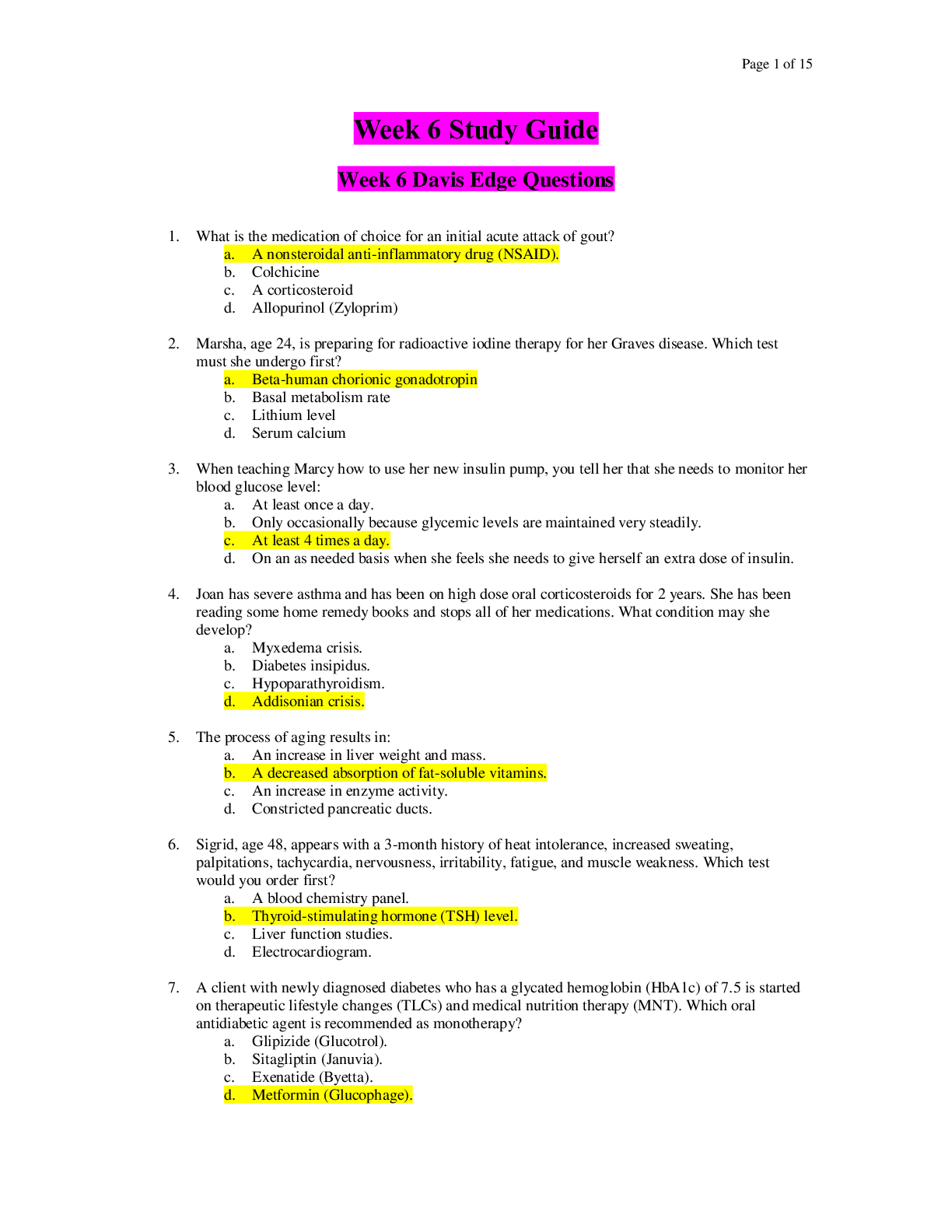
Buy this document to get the full access instantly
Instant Download Access after purchase
Add to cartInstant download
Reviews( 0 )
Document information
Connected school, study & course
About the document
Uploaded On
Dec 17, 2020
Number of pages
15
Written in
Additional information
This document has been written for:
Uploaded
Dec 17, 2020
Downloads
0
Views
47

